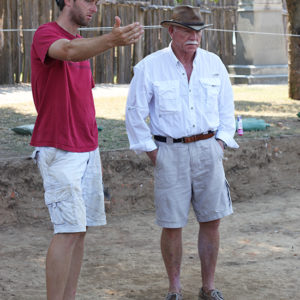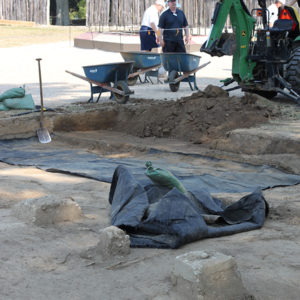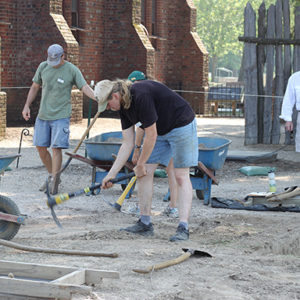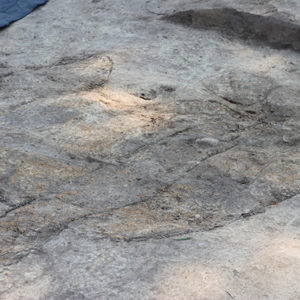Excavations near the church tower are progressing quickly now that the field school is in session and several extra sets of hands are busily digging and scraping away at soil near James Fort’s eastern palisade wall. Nearly the entire current excavation area was disturbed in 1861 as a result of the construction of the Confederate earthwork a few yards to the west. Under the disturbed layer several graves have been discovered, as have some potential fort-period features. A hilt and a blade from either a dagger or a sword were found as were a thimble and a bullet mold.
Sixteen 10′ x 10′ squares south and west of the church tower have been excavated down to the fort-period layers. Several graves are visible in the soil with the frequency of the burials decreasing as distance from the church increases. Most of the burials are aligned in an east/west direction with the exception of one which has a roughly north/south orientation. There is some discussion as to whether this feature is truly a grave, because it cuts through a layer dating to the early 20th century and there is no documentation of any burials on the property after Preservation Virginia acquired it in 1893. Another possibility is that the date of the layer itself is earlier than what is currently thought.
The majority of the current excavation area was stripped of much of its soil which was deposited just a few yards away during the construction of the Confederate earthwork in 1861. In parts of James Fort, enough soil was removed to damage or destroy the archaeological footprint, but the fort-period layers survive here. At the site of the Confederate earthwork, a large portion of which sits on top of James Fort’s archaeological footprint, the tons of added soil actually helped to preserve the colonial remains underneath from the ravages of farming witnessed elsewhere during the dig. One such example, a plow scar, is visible in the current excavation area.
Several features have been discovered in the current excavation area, some fairly modern and some perhaps dating to the fort period. Concrete footings for an iron cemetery fence have been found. The fence still stood in the late-20th century and the type of cement used points to a turn-of-the-20th-century construction date. In addition to this fence, several other postholes have been uncovered which were part of an older churchyard fence. In the upper layers Indian Head pennies and other early-20th-century artifacts are turning up. A variety of 20th-century utility lines cut through the features here as well.
Archaeologists believe they have found two fort-period features in the area as well. Two pits just a few feet in diameter have been uncovered which bear resemblance to the series of pits found inside the western palisade wall in 2005. Thought to be part of James Fort’s earliest living quarters, the pits were probably the cellar of a lean-to structure, the roof of which most likely attached to the palisade wall itself. Excavations of the two new pits will have to be done in order to learn about their form and function, but the top-most layer of one of the pits contains a substantial amount of copper scrap prevalent in other fort-period features. Early artifacts found in the excavation area include a thimble, a hasp, a bullet mold, and a hilt and blade from either a dagger or a sword.
related images
- Archaeologist Danny Schmidt removes the fill layers from a previous excavation
- Archaeologist William Kelso excavates a section of a feature near the church tower
- Archaeologists Danny Schmidt and William Kelso discuss the excavations
- Cement cemetery fence footings
- Field school students and archaeologists excavating near the Jamestown Memorial Church
- Possible fort-period pit transected by twentieth-century utility line











